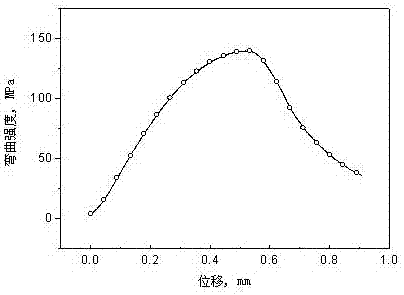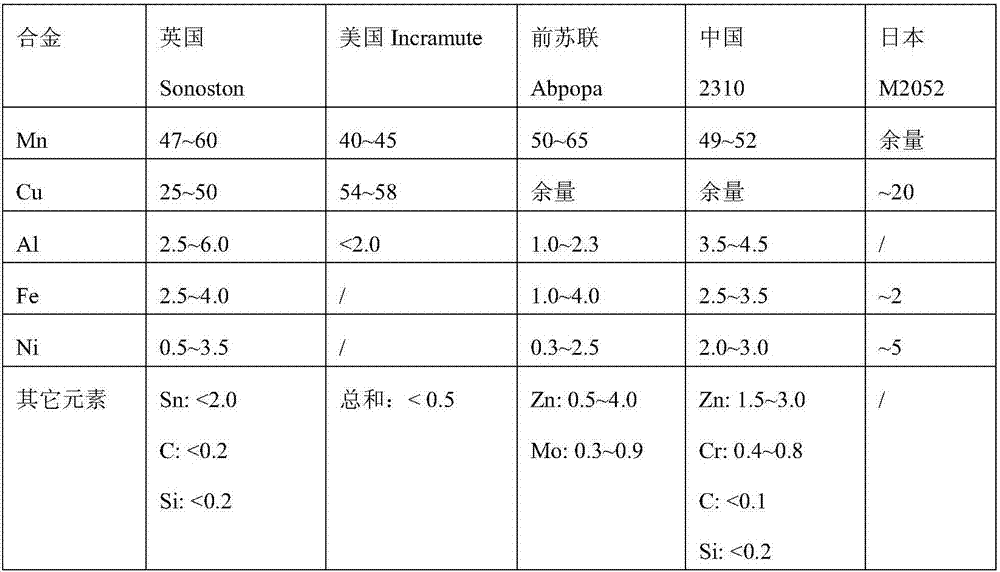The Method of Improving the Properties of Manganese Copper Damping Sintered Alloy Using Ferrous Oxalate
A technology for ferrous oxalate and sintered alloys is applied in the field of atmosphere sintering porous structure manganese-copper high damping alloys, which can solve the problems of excessive liquid phase and unfavorable shape stability of the sintered body, and achieve the effect of good uniformity
- Summary
- Abstract
- Description
- Claims
- Application Information
AI Technical Summary
Problems solved by technology
Method used
Image
Examples
Embodiment 1
[0028] Manganese, copper, nickel, aluminum, tin, carbon, silicon and other powders and ferrous oxalate are batched according to the ingredients in Table 2 Example 1.
[0029] Table 2 The composition range (mass percentage) of the manganin-copper damping alloy of the embodiment
[0030] alloy element
Example 1
Example 2
Example 3
Example 4
Example 5
Example 6
Example 7
mn
59.3
47.2
60
52
52
75
76.6
Cu
33
39
35.9
35.9
35.7
18
17
Al
3.0
6.0
2.0
1.0
4.0
/
/
Fe*
2.4
3.2
1.0
4.0
3.0
2
1.8
Ni
0.8
3.2
0.3
2.2
2.5
5
4.6
sn
0.18
1.2
/
/
/
/
/
Cr
/
/
/
/
0.6
/
/
Mo
/
/
0.2
0.9
/
/
/
Zn
/
/
0.6
4.0
2.0
/
/
C
0.16
0.10
/
/
0.08
/
/
Si
0.18
0.10
/
/
0.12
/
...
Embodiment 2
[0040] Powders such as manganese, copper, nickel, aluminum, tin, carbon, silicon and ferrous oxalate are batched according to the composition of Table 2 Example 2. Put the prepared powder into a ball mill tank for dry milling, and the ball milling time is about 3 hours until the powder is uniform.
[0041] The mixed powder was pressed into a green compact under a pressure of 300 MPa using a circular die.
[0042] Under the protection of flowing dry hydrogen, pyrolysis, reduction and sintering, the specific steps are 180°C for 4 hours; 400°C for 4 hours; 750°C for 2 hours; then 900°C for 4 hours; heating rate 5°C / minute. With the cooling of the furnace, the sintered manganese copper is subjected to solid solution and aging treatment to obtain the product. The properties of the obtained sintered compacts are listed in Table 3. figure 1 The bending strength curve of the product.
Embodiment 3
[0044] Manganese, copper, nickel, aluminum, molybdenum, zinc powder and ferrous oxalate are batched according to the composition of Table 2 Example 3. Put the prepared powder into a ball mill tank for dry milling, and the ball milling time is about 0.5h until the powder is uniform.
[0045] The mixed powder was pressed into a compact under a pressure of 500 MPa using a circular pressing die.
[0046] Under the protection of flowing dry hydrogen, pyrolysis, reduction and sintering, the specific steps are 220 ° C for 2 hours; 460 ° C for 2 hours; 800 ° C for 1 hour; then 950 ° C for 2 hours, heating rate 8 °C / min. With the cooling of the furnace, the sintered manganese copper is subjected to solid solution and aging treatment to obtain the product. The properties of the obtained sintered compacts are listed in Table 3. figure 1 The bending strength curve of the product.
PUM
| Property | Measurement | Unit |
|---|---|---|
| diameter | aaaaa | aaaaa |
| density | aaaaa | aaaaa |
| bending strength | aaaaa | aaaaa |
Abstract
Description
Claims
Application Information
 Login to View More
Login to View More - R&D
- Intellectual Property
- Life Sciences
- Materials
- Tech Scout
- Unparalleled Data Quality
- Higher Quality Content
- 60% Fewer Hallucinations
Browse by: Latest US Patents, China's latest patents, Technical Efficacy Thesaurus, Application Domain, Technology Topic, Popular Technical Reports.
© 2025 PatSnap. All rights reserved.Legal|Privacy policy|Modern Slavery Act Transparency Statement|Sitemap|About US| Contact US: help@patsnap.com



